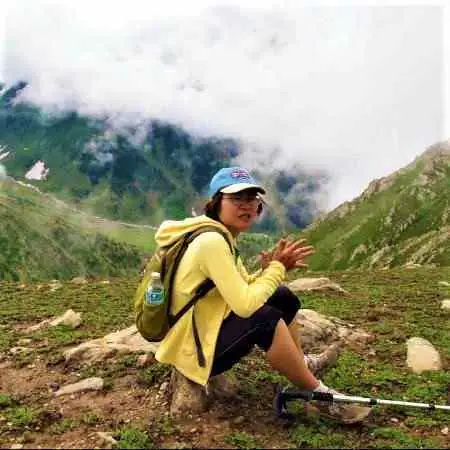The best lightweight rain-wear
By Mansha Beigh
Trekking in the rain
I always start from the principle: take as little as possible and therefore keep the carrying weight as low as possible; fast & light. Either lightweight or ultralight trekking. Because the lighter your backpack, the easier it is to move from one location to another while trekking in the rain.
I can call myself an expert in the field of trekking and surviving in the rain. I have so much experience in this field. There is no better training ground than the unspoiled wilderness of Kashmir Himalayas under extreme wet and cold conditions.

It’s actually not a problem at all to get wet while trekking, as long as you are not cold or about to get cold. Because it’s just a mindset not to find it annoying and not to let it ruin your day. It’s more about how do you deal with it and how do you keep it within limits. In other words; how do you manage it. But there is one golden rule that you must always take into account: that you never become or can become hypothermia! This is vital! Always take this seriously into account.
NB! This article is broadly based on an active multi-day trek where you stay in a tent. But it can of course also be used for an active hike or day trip where you do not stay in a tent at the end of the walking day. I say “active” because you create heat yourself when you exercise. This heat keeps you warm but also dries the clothes you are wearing. With a non-intensive trek or little effort/exercise, you do not create enough body heat and there is a risk of hypothermia.
Completely wrong
It is a big mistake to immediately put on dry clothes after hiking (after you have set up your tent) (unless you are really “too” cold). You often read this in blog articles written by trekkers who have no real “wilderness experience” in this area. Who have never trekked for several days in extreme rain, let alone spent every night in a tent. These fair weather, weekend and hut trekkers have no idea and will totally fail if they have to survive for several days in extreme cold, wind and rain in real hardcore wilderness. But even “internationally recognized” outdoor guide courses also teach their students this; Put on dry clothes after hiking… But immediately changing your wet clothes in your tent for dry clothes after hiking is “completely wrong”… and can even put you in danger…
Example: OK, so you exchange your wet running clothes with your dry (camp/tent) clothes. What are you going to wear the next rainy day; your soaking wet cold clothes from yesterday (because clothes don’t dry in your tent) or do you keep your dry, warm clothes on for the new hiking day? If you choose wet clothing, there is a chance that you will immediately become very cold and will not be able to warm up; great risk of hypothermia! Want to start the day with your dry clothes? OK, but then they will also be soaking wet on the second rainy day. At the end of the day you put up your tent, and now… all your clothes are now wet, you now have a big problem… and tomorrow it will also rain… the chance that you will get hypothermia is now very high… Or do you have one for every upcoming hike? dry clothes with you for the day…
Be a human dry machine
So how should you do it? If it is still raining outside (after you have set up your tent), sit in your tent and dry your raincoat and rain pants with a quick-drying cloth (microfiber). Just keep your rain gear and your running clothes underneath (hiking clothing according to the modern layering principle). You can’t keep your wet socks on. Squeeze this well and place/hang it in a dry place under your awning. Dry your feet and put on nice warm tent socks. Make sure everything inside your tent is dry. This is very important. So don’t sit on your sleeping bag with your wet clothes, for example. Ensure that the environment is as dry and tidy as possible. Eat some snacks and drink something warm. By staying busy in your tent you won’t get cold. The great thing is that your body heat causes your clothes to dry slowly. If you are too cold, take off your raincoat and rain pants (place them in a place where they will not unnecessarily wet your tent and gear) and put on a warm synthetic-lined jacket and/or fleece jacket (in cold conditions). Dry warm gloves and a hat help enormously to keep/get you warm. If your raincoat and rain pants are reasonably dry at some point, take them off. If it stops raining outside (for a while), you can also stand outside (if you don’t find that too cold). The wind and sun will dry your running clothes very quickly. All your running clothes will dry slowly. It takes some time to find your way around, but this drying system works. One condition is that you wear the correct quick-drying clothing as I indicate in this blog. The “old-fashioned” layer principle (for cold conditions) does not work/dry because you then have one layer too many.
With “be a human dry machine” you always have dry clothes to start your hiking day warm and pleasant. That is so nice and safe. Because this way you eliminate the chance of becoming hypothermia.
I have made extremely difficult hikes in the wettest and coldest conditions; completely self-sufficient for several days. Sometimes even just before I set up my tent I was standing up to my waist (with all my clothing on) in a cold river. This without having to bring double clothing (only warm socks for my tent, camp/tent gloves and my ultralight synthetic lined jacket). My daytime running clothes were also my camp/tent/sleep clothes. No problem. But watch out! I have a lot of experience, do not do this myself, always take double and extra tent clothing with you.
The modern layer principle
When choosing your outdoor clothing, you use the “modern” layering principle. The “old-fashioned” principle is one layer too many for when it is cold and wet. And because of this it doesn’t dry at all. The modern principle combines two layers in one warm and quick-drying garment (base and mid in one). This eliminates the old-fashioned thermal underwear and “hike” pants.
So wearing (in cold and wet weather) long warm thermal underwear, hiking pants and rain pants together is no longer fashionable. These 3 layers together do not or hardly dry. Warm sports leggings replace long underpants and hiking pants. Sports leggings dry very quickly.
Layers of clothing in cold and wet weather
Base and mid-layer in one
– warm synthetic sports leggings
– warm synthetic thermal shirt
Extra insulation for when it is very cold
– Fleece jacket*
Shell layer also provides extra warmth
– Rain jacket 2.5 layers
– Rain pants 2.5 layers
If you feel cold or warm, put on or take off a layer (fleece vest or rain-wear). Do not wear cotton clothing, only clothing made of quick-drying synthetic material. Merino wool is also a nice material, but I always prefer synthetic material; pleasant, warm and dries fastest. Never take unnecessary too much clothing with you during your trek. The less stuff, the less it can get wet.
*Do not wear a lined jacket (down or synthetic lining) in the rain.
Choice of rain-wear
The choices of lightweight rain-wear I list below are for three season conditions; spring, summer, autumn and winter (maximum slightly above freezing during the day).
Important
Familiarize yourself with the area and the weather situations. Sometimes it is wise to take extra rain-resistant and warm clothing, even if it is hot in summer. Especially in mountainous and remote areas, the weather can change dangerously.
Choice of rain-wear for warm conditions
If you go trekking in warm conditions, you basically do not need to protect yourself very much against getting wet. When it stops raining, you and your clothes will dry very quickly. What is important is that the clothes you wear dry quickly. A thin lightweight rain jacket or wind jacket is an option. Protect your equipment in your backpack against the rain, so that it does not get wet. Wear lightweight hiking or trail running shoes (without Gore-Tex) with low, quick-drying socks. Make sure you have extra dry (sleeping) clothes. And for your safety, always take rain-resistant and warm clothing with you in mountainous and remote areas.
Choice of rain-wear under mild conditions
Are the conditions milder in terms of temperature? Then it is wise to have a breathable lightweight rain jacket with you and dry clothing for your tent. In principle, rain pants are not necessary (this is an option). Your legs can take a lot and are not a real source of heat loss. Your upper body does. Furthermore, only wear quick-drying clothing. No long “normal” hiking pants, but short quick-drying sports pants or long sports leggings for the evening or when it is a bit cold. Wear low, lightweight hiking or trail running shoes (without Gore-Tex) with quick-drying low socks. Naturally protect the contents of your backpack and the like from getting wet. Make sure your hiking clothes dry again by keeping them on after hiking. Then you have clothes to dry again the next morning. Always take rain-resistant and warm clothing with you in mountainous and remote areas.
Choice of rain-wear for cold conditions
Are conditions colder or could they get cold? Then you protect yourself against rain with a light, breathable rain jacket and rain pants. Rain pants that you can easily put on and take off over your shoes are quite useful. If it’s really cold and you need to wear gloves, waterproof and breathable over-mitts are a must-have. Furthermore, only wear quick-drying clothing. No long “normal” hiking pants (with long thermal underpants underneath) but warm sports leggings. A quick-drying warm shirt (with fleece layer), a fleece jacket and a hat will keep you nice and warm. Walk in low, lightweight hiking or trail running shoes (without Gore-Tex) with quick-drying socks. Protect your equipment in your backpack from rain. And make sure you have extra dry, warm clothing for your tent. Make sure your hiking clothes dry again by keeping them on after hiking (if you are not cold). Then you have clothes to dry again the next morning.
The best lightweight rain-wear
Nowadays there are so many types of rainproof and breathable membranes and coatings that I will not mention them separately. Almost every brand has its own version. How the membrane/coating is incorporated into the jacket is important for your choice. The options are 2, 2.5 and 3 layers.
If you are going to hike for more than 1 day in wet conditions, only use breathable rain-wear of the 2.5 layer principle. Do not use 2 or 3* layers because they do not dry quickly once they are thoroughly wet. With the 2.5 layer principle, there is a membrane/coating on the inside of the thin fabric. This actually makes it a 1-layer garment that dries very quickly when it gets wet and when it stops raining. 2 and 3* layers do not dry or dry with difficulty in wet conditions and can therefore cause hypothermia problems if you hike for several days*. Also make sure that the raincoat has a well-fitting hood where you can tuck your face in and your neck is not open, so that the wind cannot blow rain into it. Very important.
Explanation of layers of rain gear
2 layer: the membrane is glued to the inner layer of the fabric and has a loose lining to protect the membrane. This 2 layer option is not a good choice for several days of hiking in wet conditions. Due to the construction, the materials used and the extra lining of the garment, it is very difficult to dry. These are also often not lightweight jackets. So not a good option.
2.5 layers: the membrane/coating is glued to the fabric on the inside and is usually protected by a thin layer of varnish. This makes the whole thing lighter, but less durable. The outer fabric used is usually made of a thin, quick-drying material. 2.5 layers is the best option for several days of hiking in wet conditions. It is lightweight, protects well against rain and cold and dries very quickly when it stops raining. This quick drying makes it perfect for several days of hiking in wet conditions.
3 layer: the membrane is glued between the inner and outer layers of the garment. This increases durability, but does not dry properly once it gets wet*. Not a good option for several days of hiking in wet conditions. These jackets are also often not lightweight*.
*Nowadays there are innovative outdoor and trail running brands that make beautiful hi-tech breathable rain-wear where 3 layers are also lightweight and dry quickly. These are very expensive to purchase.
There is no such thing as waterproof and breathable
But there is actually no such thing as waterproof and breathable. Breath-ability is the problem because there are very small microscopic “holes” in the membrane/coating to make it breathable. It would be better to call it water-resistant. Truly 100% waterproof are clothing and shoes that do not breathe, but in them you will sweat unbearably and you will feel very stuffy when you are active. So not an option for active activities such as hiking.
So it’s a compromise; breathable is nice, but you will eventually get wet if the rain lasts too long. This may happen quickly or it may take a while, but it will happen. Especially when there is regular, long-lasting heavy rain and also moisture due to your own perspiration. This water/moisture permeability is even the case with clothing with a +20,000 mm waterproof rating.
But with a 2.5 jacket and trousers it doesn’t matter that it gets wet inside. It protects you from the cold and dries super quickly when it stops raining. So even if you get partially wet in breathable rain-wear, it is certainly useful. Because you get much less wet and you feel much less cold than if you don’t wear math clothes.
DWR
It is not the membrane or the coating that makes breathable rain-wear repellent, but the DWR (Durable Water Repellent) layer that has been applied to it by the manufacturer. The DWR makes breathable rain-wear water-repellent, not the coating or membrane. Without DWR, all types of coatings or membranes allow water to pass through. DWR is the magic bullet that makes your breathable “waterproof” rain gear “waterproof”, not the coating or membrane. All coatings or membranes are nothing more than marketing.
Choice of shoes for the rain
The best choice for shoes are low hiking shoes or trail running shoes. No Gore-tex if conditions become very wet and you are going to hike for several days. Gore-Tex is only a great option if conditions do not get very wet or if you are only going to hike for 1 to 2 day(s). Always wear quick-drying socks in your shoes. Also do not use gaiters to keep rain and water out. That makes no sense and is just another layer that has to dry or stay wet.
Overview of lightweight clothing choices for hiking in the rain:
Warm conditions with rain*
Short quick-drying sports pants
Quick-drying shirt
Option: thin lightweight rain jacket 2.5 layers
Quick-drying socks
Low lightweight hiking shoes
Mild conditions with rain*
Short quick-drying sports pants
Option: warm synthetic sports leggings (with thin insulating lining)
Warm synthetic thermal shirt (with thin insulating lining)
Lightweight rain jacket 2.5 layers
Option: lightweight rain pants 2.5 layers
Hat
Thin gloves
Low quick-drying socks
Low lightweight hiking shoes
Cold conditions with rain
Warm synthetic sports leggings (with thin insulating lining)
Warm synthetic thermal shirt (with thin insulating lining)
Warm fleece jacket
Lightweight rain jacket 2.5 layers
Lightweight rain pants 2.5 layers
Warm hat
Thin warm gloves
Waterproof gloves
Quick-drying socks
Low lightweight hiking shoes
*Immerse yourself in the area and the weather situations. Sometimes it is wise to take extra rain-resistant and warm clothing, even if it is hot in summer. The weather can change dangerously, especially in mountainous and remote areas.
Conclusion
Wear as few layers of clothing as possible when trekking in the rain, but make sure you are not cold. Only wear synthetic quick-drying clothing and clothing that absorbs almost no water. For breathable rain-wear, choose 2.5 layers. Choose lightweight low hiking shoes and quick-drying socks. Protect the contents of your backpack 100% against getting wet. Always make sure you have dry and warm clothing for your tent. You leave your wet running clothes on in your tent, your body heat dries them, unless you are too cold. This way you have dry running clothes again the next day. Getting wet is not a bad thing, it is nothing more than a mindset. But make sure you don’t feel cold or get too cold. And that you can never get hypothermia. Never underestimate this.
Important! Always make sure you have dry, warm clothing in your tent in case you get too cold! This should be warmer in cold conditions than you wear during the day while trekking. Listen to your body: stop walking prematurely before you get too cold, pitch your tent before you get past this point. The latter is very important and even vital, especially if you are alone in the wilderness. Because if you can no longer use your hands and are close to hypothermia, you can no longer set up your tent yourself and you are lost.


